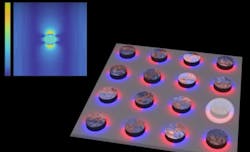Researchers at Aalto University (Espoo, Finland) are the first to develop a plasmonic nanolaser that operates at visible light frequencies and uses so-called dark lattice modes.1 The lifetimes of light captured in nanolaser dimensions are so short that the light wave has time to wiggle up and down only a few tens or hundreds of times. The results open new prospects for on-chip coherent light sources, such as lasers, that are extremely small and ultrafast.
RELATED ARTICLE: Surface plasmons and nanolasers: A big push for very small lasers
The laser operation in this work is based on silver nanoparticles arranged in a periodic array. In contrast to conventional lasers, where the feedback of the lasing signal is provided by ordinary mirrors, this nanolaser uses radiative coupling between silver nanoparticles. These 100 nm sized particles act as tiny antennas. To produce high intensity laser light, the inter-particle distance was matched with the lasing wavelength so that all particles of the array radiate in unison. Organic fluorescent molecules were used to provide the input energy (the gain) that is needed for lasing (see video below):
A major challenge in achieving lasing this way was that light may not exist long enough in such small dimensions to be helpful. The researchers found a smart way around this potential problem: they produced lasing in dark modes.
"A dark mode can be intuitively understood by considering regular antennas: A single antenna, when driven by a current, radiates strongly, whereas two antennas -- if driven by opposite currents and positioned very close to each other -- radiate very little," explains professor Päivi Törmä. "A dark mode in a nanoparticle array induces similar opposite-phase currents in each nanoparticle, but now with visible light frequencies," she continues.
"Dark modes are attractive for applications where low power consumption is needed. But without any tricks, dark mode lasing would be quite useless because the light is essentially trapped at the nanoparticle array and cannot leave," adds staff scientist Tommi Hakala.
"But by utilizing the small size of the array, we found an escape route for the light. Towards the edges of the array, the nanoparticles start to behave more and more like regular antennas that radiate to the outer world," says Ph.D. student Heikki Rekola.
REFERENCE:
1. T. K. Hakala et al., “Lasing in dark and bright modes of a finite-sized plasmonic lattice,” Nature Communications; DOI:10.1038/NCOMMS13687.
SOURCE: Aalto University; http://www.aalto.fi/en/current/news/2017-01-03/

Gail Overton | Senior Editor (2004-2020)
Gail has more than 30 years of engineering, marketing, product management, and editorial experience in the photonics and optical communications industry. Before joining the staff at Laser Focus World in 2004, she held many product management and product marketing roles in the fiber-optics industry, most notably at Hughes (El Segundo, CA), GTE Labs (Waltham, MA), Corning (Corning, NY), Photon Kinetics (Beaverton, OR), and Newport Corporation (Irvine, CA). During her marketing career, Gail published articles in WDM Solutions and Sensors magazine and traveled internationally to conduct product and sales training. Gail received her BS degree in physics, with an emphasis in optics, from San Diego State University in San Diego, CA in May 1986.
